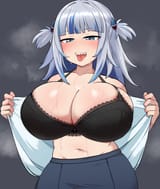Search Results
6/29/2025, 8:49:40 PM
>>101743992
The appeal of off-model fanart—especially when it involves drawing originally slim characters with exaggerated breasts and hips—stems from a combination of creative freedom, visual humor, and personal aesthetic preferences. Here's a breakdown:
1. Fulfilling Fantasies and Aesthetic Preferences
Many fans or artists have a strong preference for fuller, curvier body types. Even if a character is originally slender, artists may redraw them to reflect their ideal physique. This kind of transformation (e.g., "thiccification" or "boobification") allows for personal fantasy projection.
2. Humor from Visual Dissonance
Taking a familiar character and drastically altering their proportions creates a sense of visual shock and surprise. This contrast—“they weren’t like this before, now they are”—adds a layer of humor and novelty that draws attention and entertains.
3. Creative Freedom and Fan Culture
Off-model art is a staple in fan communities, emphasizing the artist’s personal style and reinterpretation. It’s a way of saying, “I’m not bound by the original design,” and serves both as a showcase of artistic freedom and as a way to connect with niche audiences.
4. Subcultural Norms and In-Group Language
In certain online communities (such as Rule34, Pixiv, or NSFW Twitter circles), turning slim characters into voluptuous ones has become a meme or tradition. It reflects shared tastes, inside jokes, and a kind of visual language among fans.
In Summary:
> The appeal of off-model fanart lies in its freedom from canon, fulfillment of personal tastes, and exaggerated visual reimaginings. Whether it's about sexual fantasy, subcultural humor, or creative reinterpretation, it’s all part of how fanart transforms existing media.
The appeal of off-model fanart—especially when it involves drawing originally slim characters with exaggerated breasts and hips—stems from a combination of creative freedom, visual humor, and personal aesthetic preferences. Here's a breakdown:
1. Fulfilling Fantasies and Aesthetic Preferences
Many fans or artists have a strong preference for fuller, curvier body types. Even if a character is originally slender, artists may redraw them to reflect their ideal physique. This kind of transformation (e.g., "thiccification" or "boobification") allows for personal fantasy projection.
2. Humor from Visual Dissonance
Taking a familiar character and drastically altering their proportions creates a sense of visual shock and surprise. This contrast—“they weren’t like this before, now they are”—adds a layer of humor and novelty that draws attention and entertains.
3. Creative Freedom and Fan Culture
Off-model art is a staple in fan communities, emphasizing the artist’s personal style and reinterpretation. It’s a way of saying, “I’m not bound by the original design,” and serves both as a showcase of artistic freedom and as a way to connect with niche audiences.
4. Subcultural Norms and In-Group Language
In certain online communities (such as Rule34, Pixiv, or NSFW Twitter circles), turning slim characters into voluptuous ones has become a meme or tradition. It reflects shared tastes, inside jokes, and a kind of visual language among fans.
In Summary:
> The appeal of off-model fanart lies in its freedom from canon, fulfillment of personal tastes, and exaggerated visual reimaginings. Whether it's about sexual fantasy, subcultural humor, or creative reinterpretation, it’s all part of how fanart transforms existing media.
Page 1
